Hanergy shows off new charging tech
Firm’s charging stations with thin-film panels used at Formula E race

Drivers take part in the inaugural Formula E all-electric auto race in Beijing Saturday. Photo: CFP

Hanergy Holding Group, which is cooperating with Tesla to build charging stations in Beijing, was able to show off the capability of its charging products at the FIA Formula E Championship, which kicked off in Beijing on Saturday.
The championship is the first-ever full electric car race series, aimed at promoting the development of motorsport powered by green energy. Beijing is the first leg of the championship that will take place in a number of global cities to promote the electric car industry.
Beijing-based Hanergy is providing fast deployment solar charging products for the event, and paraded the advantages of its products, which are based on flexible, lightweight thin-film photovoltaic modules.
Hanergy struck a deal with US electric car manufacturer Tesla Motors in April to build two charging stations in Beijing for the automaker's Model S, which is slowly starting to penetrate the Chinese mainland market in small but steady numbers.
Hanergy's charging station would generate and store electricity and charge cars without the need to stay connected to utility companies like the State Grid, giving Tesla ready-to-use options rather than engaging in lengthy negotiations with the utility companies.
In the US, Tesla's partner SolarCity is gradually spreading its charging network with newly installed capacity reaching 567 megawatts in 2013, business news portal yicai.com reported over the weekend.
Experts say the thin-film solar panel technology has great potential in market applications but also has issues that need to be dealt with before it can become a full success.
Lin Boqiang, director of the China Center for Energy Economics Research at Xiamen University, told the Global Times on Sunday that despite its status as a latecomer, China could eventually become a leading country in the world in utilizing off-grid charging stations, referring to China's desperate need for more cars powered by cleaner energy.
But Lin said the process may take five to 10 years to realize.
Besides charging top-level sports cars, Hanergy's charging stations, which are equipped with thin-film solar panels, can be easily packed up and moved around, to cater for off-grid needs by other consumers and commercial entities, such as businesses powered by solar panels, according to a news release on the company's website.
The company estimated that sales of its charging stations in 2014 would reach 50 sets, the report said.
Compared with the traditional glass-encapsulated modules used by crystalline solar cells, the thin-film solar panel works better under a cloudy sky with better conversion rates, experts said.
Lin said the thin-film solar panel exceeds the traditional solar panel in competitiveness by a thin margin so far, mainly with its lower operational cost.
Because the thin-film panels are extremely light, it only takes four workers half an hour to assemble a Hanergy charging station.
The sunshine in Beijing could enable a charging station to generate 70 kilowatt hours of electricity each day, satisfying the basic needs for 200 to 400 people, according to the company's report.
But Zhao Zheng, a professor at the School of Economics and Resource Management at Beijing Normal University, said the cost of running facilities powered by thin-film solar panels is still debatable.
"Although the crystalline panels' energy converting ability is lower than thin-film panels, their price is quite low due to China's supply glut. This has led to utility firms procuring a large number of crystalline solar cells as stock," Zhao told the Global Times on Sunday.
Hanergy estimated that the global market demand for off-grid charging stations could exceed 2 gigawatts of capacity, without specifying a time frame.
Hanergy faces some risks from the differing specification of charging facilities used by different brands, Lin said. In the future, there will be negotiations for a more unified industrial standard in China, noted Lin.
On the other hand, there is a growing competition between the two kinds of solar panels.
"It begs the question as to whether off-grid charging stations will take the lion's share of the market as the two forces compete. After all, electricity supply is the territory of State-owned firms," Zhao said, it would be hard for thin-film technology to compete against crystalline solar panels that are backed by State-owned firms.
Li Hejun, founder and chairman of Hanergy, ranked 4th on the 2014 Forbes China rich list with a net worth of $10.9 billion.
On August 13, Hanergy Holding Group announced the purchase of Alta Devices Inc, a California-based developer of thin-film solar cells.
The acquisition came a year after Hanergy bought Arizona-based Global Solar Energy Inc.